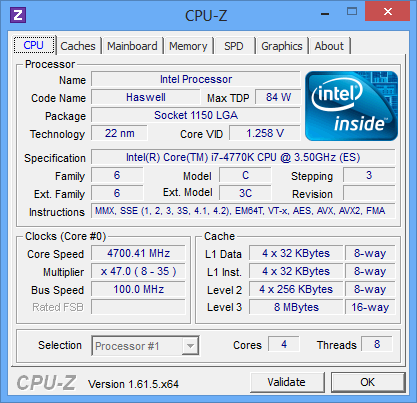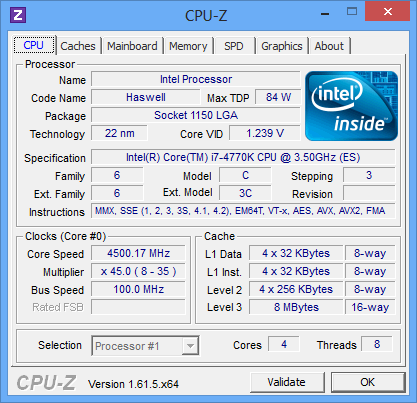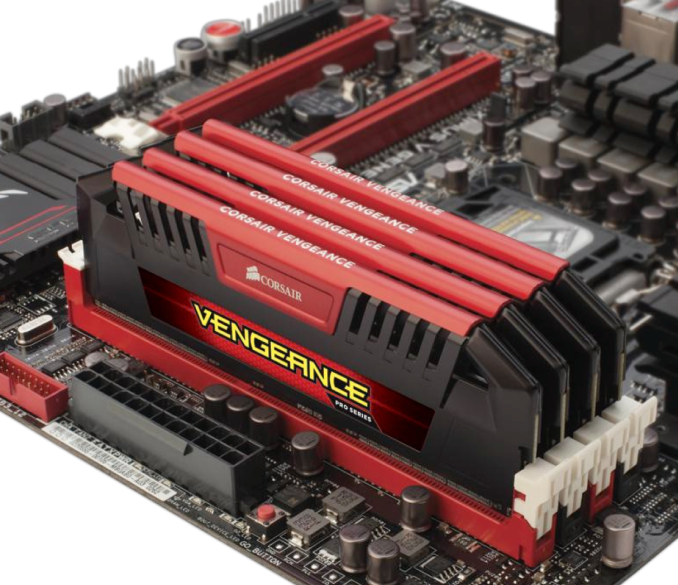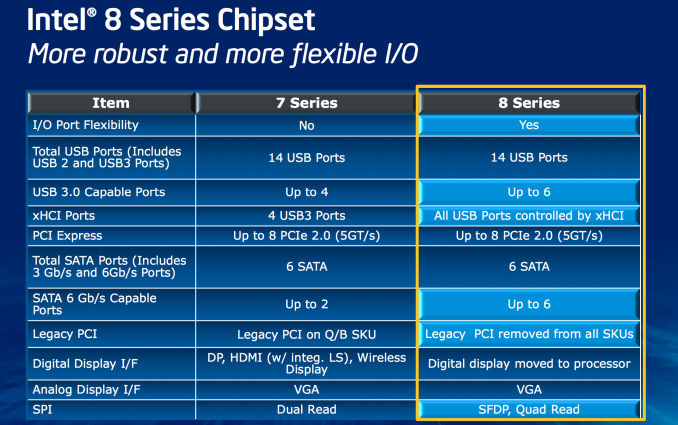The Haswell Review: Intel Core i7-4770K & i5-4670K Tested
by Anand Lal Shimpi on June 1, 2013 10:00 AM ESTMemory
Haswell got an updated memory controller that’s supposed to do a great job of running at very high frequencies. Corsair was kind enough to send over some of its Vengeance Pro memory with factory DDR3-2400 XMP profiles. I have to say, the experience was quite possibly the simplest memory overclocking I’ve ever encountered. Ivy Bridge was pretty decent at higher speeds, but Haswell is a different beast entirely.
Although I used DDR3-2400 for most of my testing, Corsair’s Vengeance Pro line is available in frequencies rated all the way up to 2933MHz.
Platform
Haswell features a new socket (LGA-1150). Fundamental changes to power delivery made it impossible to maintain backwards compatibility with existing LGA-1155 sockets. Alongside the new socket comes Intel’s new 8-series chipsets.
At a high level the 8-series chipsets bring support for up to six SATA 6Gbps and USB 3.0. It’s taken Intel far too long to move beyond two 6Gbps SATA ports, so this is a welcome change. With 8-series Intel also finally got rid of legacy PCI support.
Overclocking
Despite most of the voltage regulation being moved on-package, motherboards still expose all of the same voltage controls that you’re used to from previous platforms. Haswell’s FIVR does increase the thermal footprint of the chip itself, which is why TDPs went up from 77W to 84W at the high-end for LGA-1150 SKUs. Combine higher temperatures under the heatspreader with a more mobile focused chip design, and overclocking is going to depend on yield and luck of the draw more than it has in the past.
Haswell doesn’t change the overclocking limits put in place with Sandy Bridge. All CPUs are frequency locked, however K-series parts ship fully unlocked. A new addition is the ability to adjust BCLK to one of three pre-defined straps (100/125/167MHz). The BCLK adjustment gives you a little more flexibility when overclocking, but you still need a K-SKU to take advantage of the options.


In terms of overclocking success on standard air cooling you should expect anywhere from 4.3GHz - 4.7GHz at somewhere in the 1.2 - 1.35V range. At the higher end of that spectrum you need to be sure to invest in a good cooler as you’re more likely to bump into thermal limits if you’re running on stable settings.

















210 Comments
View All Comments
eckre - Friday, June 14, 2013 - link
VERY disappointing CPU, if you disregard ALL of the fake synthetic benchmarks, and use only the real world ones, the gains over the 3770K are 0.03%, max 8.8% and average at about a 3% Improvement. 3%? Not worth it. Motherboard? Z87 was suppose to drop PCI but all the motherboards still have it and nothing outrageous. So basically lower power consumption, better on board video performance and no discernible improvement over the 3770K.i7Ahmed920D0 - Monday, June 24, 2013 - link
GOOD BYE 920 D0 Ill never forget you ! Your going to moms rig ! Helllllooooo 4670k with upto 40% better performance for 225 bucks !Yangorang - Thursday, June 27, 2013 - link
There are some rumors that the Haswell desktop processors run fairly hot - can you confirm this at all in your testing?calico-uk - Friday, July 12, 2013 - link
Face it, A consumers market, not a true imagine of technology evolution. Low power with high temps? Just doesn't ring true, unless the chip has been purposely ' Restricted ' with only one cause in mind sales and protection of future sales. In layman's terms Greedy bastards more concerned with markets and money and not the Desktop guy who's impressed with performance. Blame Mac, Windows 8. And your tiny fucking phone.James McGrath - Sunday, August 11, 2013 - link
This test is a little bias against the Core 2 duo I think. What they have done is essentially pitch the very top end on Intel's last 4 generations against a mid to low end core 2 duo. It would be more fair if that generation was represented by a qx9770 or even a Q9650.clyman - Wednesday, October 23, 2013 - link
I have been involved in computer hardware, software and programming since 1986. There has never been a more reliable processor than Intel, at any time. The current ones still have to be tested over time, but I would not buy one. If you put enough case fans with the inferior processors, they might last 2 or 3 years. With an Intel processor, even overclocked with no case fans, provided you used the intel chipset, nearly 100% of them kept running for 5 or more years. Without overclocking, I still don't know when they will die, since none have to my knowledge. I have built at least 100 computers and have only built a couple non intel ones. It was obvious right away how inferior they were to intel. Also, I love my i7 haswell on an asus z87-pro motherboard. There is no need to overclock, the processor and memory score 7.8 out of 7.9 on the windows scale and the onboard graphics scores a 6.8. Not bad ratings. Also, the CPU only uses 7 to 8 watts of power most of the time.numskulll - Tuesday, November 5, 2013 - link
I'm quite happy with my undervolted Athlon 620 and Radeon 4200 graphics. More computing power than I need 99% of the time, estimated tdp of about 55-60 watts (1% of use) and system idle of about 40w (80+% of use). And if I ever play games it takes a few seconds to bung in a suitable graphics card. I doubt it will go belly-up in the foreseeable future, but if it does it only cost £50 second-hand about 3 years ago and would be even less to buy now.duttasanjiv - Friday, November 14, 2014 - link
I am planning to get a new i5 4690 system for 1080p transcoding. I am not interested in GPU assisted transcoding. My focus is on QuickSync assisted transcoding. It is said that latest Quicksync is almost comparable to CPU based transcoding.It is annoying to see all sites compare only obsolate systems with a vague spec. (including AnandTech). Then, they omit any screenshots. Some are so weird thay put the video at youtube!! How can one compare the quality after youtube again transcoded it?
So far I am looking for a scientific, specific comparison on -
1) i5 4690 or atleast 4570 with CPU only & with QS
2) Screenshots in PNG
3) Specifying what settings were used? What QRF / what QCF? What speed presets - 'slow' or medium? What profile - high or main?. 'faster' or 'very fast' settings speed presets is worthless.
2) What is the source format - 1080i or 1080p? How long? What was the target size.
3) What QuickSync performance settings were used? I heard that haswell supports 7 performance vs quality settings. Also never found if QS supports any other parameters.
Merely mentioning FPS or time won't help.
I request you to pl. provide us with such an comprehensive comparison with will help many users like me, to settle all doubts for good. Thx so much in advance...
minitt - Sunday, December 7, 2014 - link
They dropped I5 750 and I7 920 from the gaming benchmark because both the processor will put up decent FPS which will take away most of the lime light from the haswell. A 4.0 ghz clocked i5 750 or i7 920 is still capable of keeping the modern GPUs running at 100% .I would be more than happy if someone can prove me wrong.Miller1331 - Tuesday, December 1, 2015 - link
I have the 4770k in my Desktop which is used primarily for high end music production and it eats up everything I have thrown at it thus far